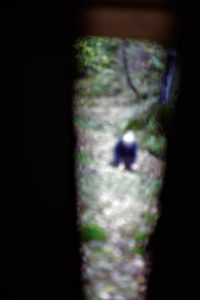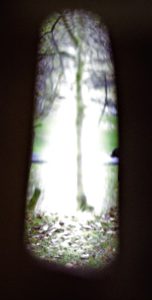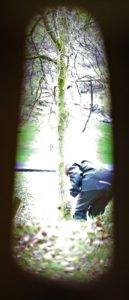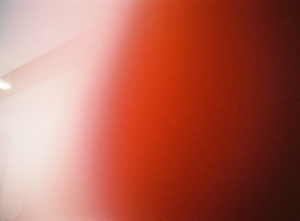As part of my PhD data collection, I co-led a workshop in Norway with a creative teacher who conducted a landart workshop with students from a Folk School. My aim was to see how empathy emerges from the relationships between the human and nonhuman when students and the environment are co-creating. Much of my data collection comprised of photographic images and a padlet collage was made of these with students own images too (alongside writing, sounds, video). When sifting through my second set of photographs I noticed that some of the images had become distorted with light when I was trying to capture different angles of the landart making session. This made the images look like something else, something ghostly, and it made me think about the importance of distortion, differing lights and shadows, absences and lack of aesthetic to my understanding of environmental empathy.



Figure 1 Photos of landart making
This led me to think about how photography plays a part in non-human centred research.
Photography has historically been viewed in relation to the dualist notion of the photographic subject/object, limiting its outcome to what it means only to the human. A photograph usually depicts something that is familiar to us which is then interpreted through a projection of our own linear sense of space and time. This means that the photograph is the property of the photographer and favours representations designed to be viewed only by a human eye: ‘The message of photography is that we, the humans are species apart, because we possess the rational view of the world, we own the vantage point from which everything can be observed as a reflection, a copy and a representation’ (McKinnon, 2017). If this is the case, a photograph which depicts human relations within the environment is understood as a story which is told from the perspective of the human only and is therefore laden with inequalities through the exclusion of the natural world itself. These inequalities are often further extended through the eyes of other humans who can read and depict the image in a different light and is quite often used as a political instrument for their own gain. Here the photograph becomes a superficial political object which changes over time. However, the photograph is much more than that if viewed from a non-human centred perspective. Up until now ‘both the photographer’s vantage point and the process of watching photographs has emerged as only one component within a whole, very complex fabric of relations’ (Azoulay, 2021, p18). By taking a non-human centred perspective the photograph can be viewed as an ontological and material event where attention is paid to agencies that are in operation when making, or taking, a photograph, expanding the possibilities of photography beyond just the object. So how can this be done? The starting point is to attempt to unravel the entanglements which are present within the action of photography to begin to question the ethics of the power relations within them.
So, what do I need to consider when taking a Photograph? Firstly, I need to understand where the camera came from and how I managed to gain access to being able to use one. What is entangled in the construction of the camera? What materials are used in its making and how are they resourced? Are the metals ethically mined? Are the plastics degradable? Is the glass ethically made? How are the mechanics constructed to make the camera work? Who put the pieces together? What happens in the moment that the shutter is pressed? How does the eye and hand play a part and how is the body extended during this action? These questions are important because ‘Materiality refers here to a decision to focus upon the materials of engagement such as the processes of production and their subsequent power relations; the invisible workers that build components; and the otherwise black-boxed complexity of interactions that make the photographic event possible’ (Azoulay, 2021, p6). These questions allow me to think deeply about the ethics of photography in my data through the material circumstances of the existence of the camera and what it produces. This makes photography both material and ontological at the same time.
Other questions I need to take into consideration are why do I have access to a camera? What are my privileges that allow me to be able to buy a camera and use it? My camera is semi-professional, and my lenses are very expensive so not everyone would be able to afford to own one. With images having the power to inform and move people politically, the photographer who can afford to buy a camera finds themselves in a position of power with huge responsibility. As Sontag (1977) argued, the image alone does not constitute meaning, it is the way it is displayed that are a huge part of how the image is interpreted by others. Explaining this further Butler (2008) argues that when we interpret a photograph, we view it under the structure that it is displayed, and it is this structure which causes the affective transmission of the image. This means that any photograph which is displayed by a human is deliberately meant to cause affect and emotion in some way.
This can still be seen with images which are displayed for media purposes. However, with the invention of smartphones there are more people who do have access to cameras these days, making photography less exclusive and enabling the blurring of boundaries between borders or laws (MacKinnon, 2017). This means that the structure that Butler refers to is slowly being dismantled and the image can no longer be reduced to an object which is interpreted for a specific meaning, rather it now ‘pertains to particular contextual resonance’ (MacKinnon, 2017, pg3).
So, coming from a non-human-centred perspective, Posthuman photography moves away from showing what the world looks like to showing the relationships between interconnected entities without suggestion of beginning, ending or representation. As MacKinnon (2017, pg3) argues we need to ‘think of photography as a multiple, proliferating structure that reproduces itself through exponential multiplication, simultaneously engaging in visual, economic, social and political production’. This means that I, as the researcher/photographer am no longer the only author of the image even though it is me who decides what to capture, it is produced by all the entities that are interconnected in the moment the photograph is taken. The trick is to ensure that the agency of the other interconnected entities’ are present in the gathering and understanding of the data. So where do I begin?
Allen (2016) argues that although conventional understandings of the camera see it as ‘dumb matter’ (Massumi, 2002, p.173) without agency because it is not a living thing and is entirely operated by humans, there are ways in which it can gain some agency through alternative methods. I argue that one of these methods is to understand as much as possible the entanglements within the production of the camera as I have previously highlighted, and to use it ethically with these in mind. The method discussed by Allen (2016) is that of accidental activation of the camera. However, both of these methods do not give intrinsic agency to the camera so this is something that would need further exploration.
However, Allen (2016) provides some clear explanations of how to choose and look at photographic data from a non human-centred perspective. Drawing from Koro-Ljungberg and MacLure (2013) Allen argues to move away from photographic data which seems familiar to make it more problematic. This means shifting away from sifting through photographic data to find trustworthy, reliable material which accurately ‘mirror’ photographic objects, because this often excludes problematic data which, when acknowledged, could lead to a form of ‘newness’ in the research. To do this Allen (2016) draws from Lenz Taguchi (2010) to use a methodological strategy called ‘exorbitant deconstruction’ (pg.14) which involves a ‘turning, bending and twisting’ of conventional thinking ‘to try and displace the meanings of it; in order to identify…..what other analysis might be possible’ (pg.14). Allen uses this idea to choose some photographs which were previously discarded due to them representing nothing in the data.

Figure 2 Photo of nothing – Allen (2016)
To action this choice, affect theory is drawn upon through the use of Maclure’s (2013) strategy which moves away from coding to feeling the ‘wonder of data’. However, instead of waiting for a specific ‘gut feeling’ of the data, Allen (2016) turns to ‘affect nothing’ where no feeling has been felt from the images. To ‘analyse’ Allen then uses a technique which was first used by Springgay and Zaliwska in 2015 called ‘edging’ which helps the researcher to move away from trying to impose meaning onto the visual images by paying attention to the edges of representation. Here ‘newness’ of the research is created by choosing the previously discarded images and reading them in a non-traditional way. However, I argue that by choosing and reading the images, there is still an element of human-centredness so again, further exploration of this is needed.
To conclude, I have learned that in order to use photographic data in my non-human-centred research I need to think ethically about the use of the camera by paying attention to the materiality of its construction and the entanglements that are involved in this. I also need to think about the power relations involved in taking, selecting and displaying my photographs. Techniques such as giving agency to the camera body and the entanglements involved in the image creation, then deconstructing the image in different ways to create ‘newness’ need to be drawn upon. And finally, exploration of how to decentre the human even further needs to be implemented. To do this I will begin by seeing the camera body as an extension of my own and think about how the vibrations of my body animate with what the image gives and withholds (Lorenz-Mayer, 2018). I will then create an ongoing embodied dialogue with my camera to explore the ethical relations of the entanglement within it for my PhD.
References:
Allen, L (2016) Photos of (no)thing: The becoming of data about sexuality at school. Reconceptualizing Educational Research Methodology 2016, 7(1).
Azoulay, A (2015) Civil Imagination: A Political Ontology of Photography. Louise Bethlehem, trans, Verso, London, p 23.
Lorenz-Mayer, D (2018) Snapshot. [online] available at: https://newmaterialism.eu/almanac/s/snapshot.html. Accessed 3.1.22.
MacKinnon, L (2017) Toward a materialist photography: the body of work. Third text, 30 (3-4). Pp. 149-158.
